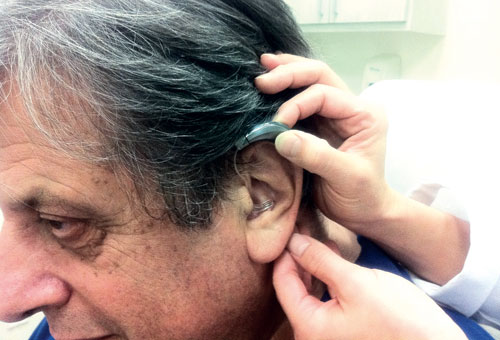Being able to communicate with ease has been determined to be a critical topic and aspect of healthy aging. Since 2014, a greater emphasis has been placed on hearing health and associated disease risk factors including the following life threatening co-morbidities:
Dementia. Dr. Frank R. Lin, M.D., Ph.D., otolaryngologist and investigative researcher at Johns Hopkins University, conducted studies linking hearing loss with cognitive processing decline. His MRI studies performed over a 10-year period suggested that, “declines in hearing abilities may accelerate gray matter atrophy.” He added that seniors with hearing loss are significantly more likely to develop dementia and Alzheimer’s disease than those who retain their hearing. Dr. Lin noted further that hearing aids may not only improve hearing but may, indeed, “preserve the brain.”
Diabetes. In 2008, researchers from the National Institutes of Health reported that patients with diabetes are more likely to suffer from sensorineural hearing loss with a greater association in the high frequency range. Furthermore, post mortem studies of diabetic patients reveal pathological changes to the nerves and blood vessels of the inner ear.
Falls. A common contributor to falling and balance disorders is untreated hearing loss according to the Center for Disease Control and Prevention (2013). Researchers noted a link between hearing loss and an increased chance of falling. US News.com in 2012 reported that patients with a mild 25dB hearing loss were three times more likely to fall than those with normal hearing. They further indicated that every additional 10 decibels of hearing impairment meant an increased 1.4 fold risk of falling.
Cardiovascular disease. Studies conducted by the Better Hearing Institute (2013) suggested “a growing body of research shows that a person’s hearing health and cardiovascular health frequently correspond.” They noted that an early sign of cardiovascular disease can be linked to sensorineural hearing loss in the lower frequency range of the audiogram. Decreases in blood flow and blood vessel trauma are linked, affecting inner ear function.
Ototoxicity. Finally, certain chemotherapy medications and radiation therapies can cause ototoxicity which can have long-term implications including sensorineural hearing loss, tinnitus and balance disorders. Damage to inner ear structures where hair cells are located can detrimentally affect how information is transmitted to the brain. According to Siemens, “the most common ototoxic cancer treatments associated with hearing damage are platinum-based chemotherapy agents (cisplatin and carboplatin in particular) and radiation of head and neck.”
It is critically important to counsel patients regarding the consequences of ignoring their hearing loss. Researchers at Siemens Hearing Instruments concluded that, “people with hearing loss on average wait seven years from when they are diagnosed to seek treatment, even though, the sooner hearing loss is detected and treatment begins, the more hearing ability can be preserved.”
In conclusion, it is important for both the physician and patient to understand the relationship between hearing loss and associated disease risk factors. These life-threatening co-morbidities should be addressed with baseline audiological testing. These evaluations should be included for patients to enable the primary care physician, in cooperation with the medical specialists, to be proactive in addressing any hearing declines and potential health risks over time.
Lisa Nathan Bellows is an audiologist practicing in Palm Desert and is a member of Desert Doctors. She can be reached at (760) 340.6494. For more information visit DesertDoctors.org or call (760) 232.4646.
References available upon request.










































Comments (0)